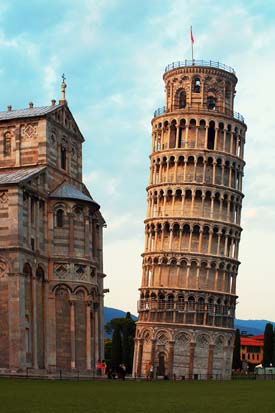Tower of Pisa – Foundation Problems?
The Tower of Pisa is one of the most famous buildings in the world because it has been leaning at a gravity-defying angle for over 800 years. The world wonders when it will collapse because in 1989 a similar leaning bell tower in the town of Pavia, Italy collapsed without warning. When this happened the civic officials closed the Tower of Pisa to the public fearing its imminent collapse.
Why does the Tower of Pisa lean?
All man-made structures are supported by the ground (soil) underneath. If the soil (or rock) is strong and durable then the building or structure should have few or no problems during its lifetime. However, if the soil is soft, easily compressed, and/or shrinks/swells then the structures built on top will experience movement.
The Tower of Pisa, and its foundation, is built on soft soil that is primarily sand, mud, and clay. The original builders realized they had a problem by the time the third story was being built. Their solution was to build the arches and columns on one side of the third story taller to compensate for the lean. Later both the fifth and final (eighth) stories were also built with slightly taller arches and columns on one side of the building. Unfortunately, these uneven floors did not solve the problem, which was soft and unstable soil.
The Stabilization
Modern technology and engineering were finally applied to the Tower of Pisa a few decades ago. Basically, the engineers wrapped the lower floors with steel bands while they removed some soil under one side of the building. They also used cables and over 800 tons of lead weights to try and pull the tower closer to a vertical orientation. Over a period of years their efforts were considered successful and the angle of lean was reduced from over 5 degrees to 3.97 degrees. The overall decrease in the lean was 19 inches.
The engineers think that the Tower of Pisa is now stable enough to survive the next 200 years barring any severe earthquakes. And the Tower of Pisa is now open to the public once again.
The Leaning Tower of Pisa is a great example of the importance of stable soil for any building or home. More information about the Leaning Tower of Pisa can be found at its Wikipedia web page.

